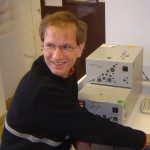Link to Pubmed [PMID] – 27070312
PLoS ONE 2016;11(4):e0153401
Botulinum neurotoxin A (BoNT/A) is composed of three domains: a catalytic domain (LC), a translocation domain (HN) and a receptor-binding domain (HC). Like most bacterial toxins BoNT/A is an amphitropic protein, produced in a soluble form that is able to interact, penetrate and/or cross a membrane to achieve its toxic function. During intoxication BoNT/A is internalized by the cell by receptor-mediated endocytosis. Then, LC crosses the membrane of the endocytic compartment and reaches the cytosol. This translocation is initiated by the low pH found in this compartment. It has been suggested that LC passes in an unfolded state through a transmembrane passage formed by HN. We report here that acidification induces no major conformational change in either secondary or tertiary structures of LC and HN of BoNT/A in solution. GdnHCl-induced denaturation experiments showed that the stability of LC and HN increases as pH drops, and that HN further stabilizes LC. Unexpectedly we found that LC has a high propensity to interact with and permeabilize anionic lipid bilayers upon acidification without the help of HN. This property is downplayed when LC is linked to HN. HN thus acts as a chaperone for LC by enhancing its stability but also as a moderator of the membrane interaction of LC.


